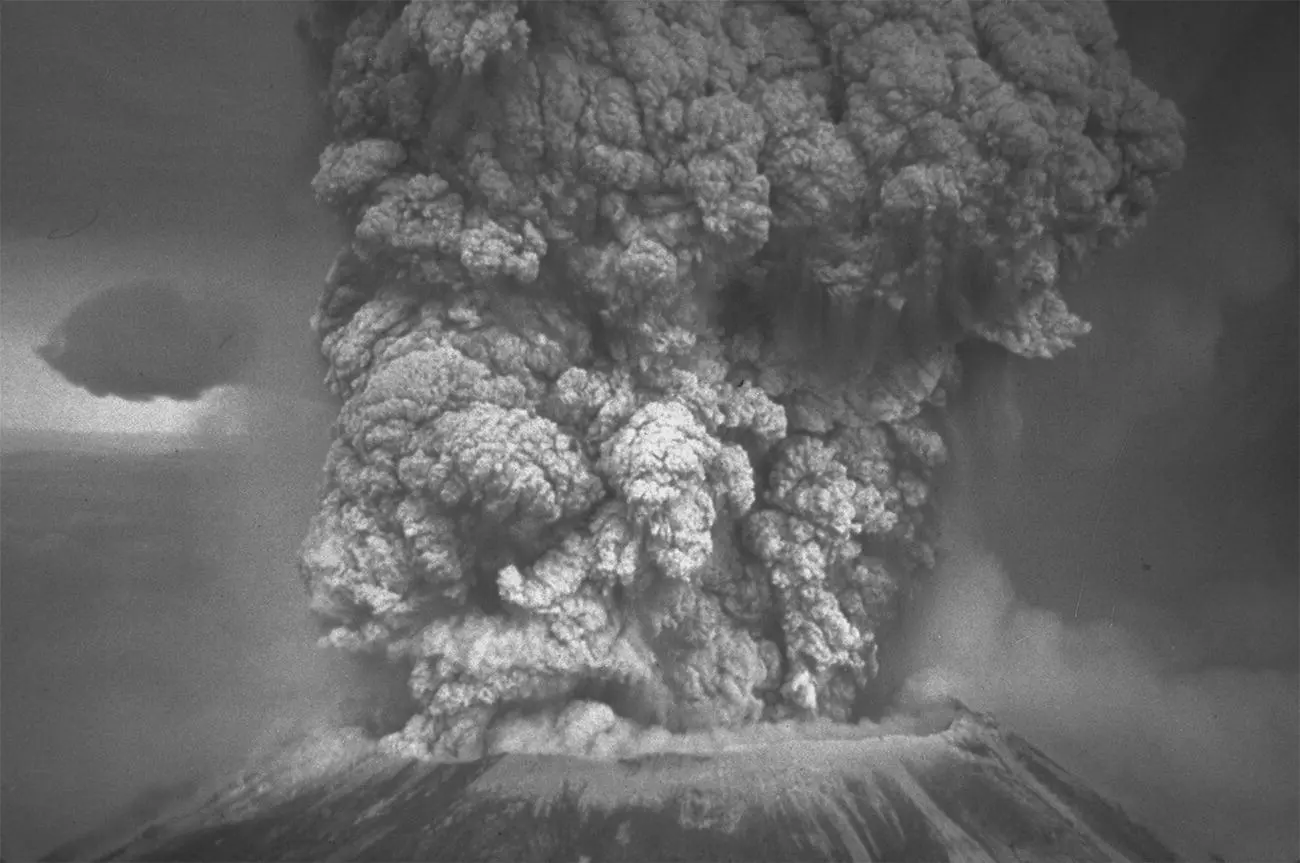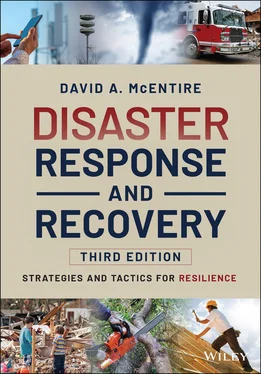David A. McEntire - Disaster Response and Recovery
Здесь есть возможность читать онлайн «David A. McEntire - Disaster Response and Recovery» — ознакомительный отрывок электронной книги совершенно бесплатно, а после прочтения отрывка купить полную версию. В некоторых случаях можно слушать аудио, скачать через торрент в формате fb2 и присутствует краткое содержание. Жанр: unrecognised, на английском языке. Описание произведения, (предисловие) а так же отзывы посетителей доступны на портале библиотеки ЛибКат.
- Название:Disaster Response and Recovery
- Автор:
- Жанр:
- Год:неизвестен
- ISBN:нет данных
- Рейтинг книги:5 / 5. Голосов: 1
-
Избранное:Добавить в избранное
- Отзывы:
-
Ваша оценка:
- 100
- 1
- 2
- 3
- 4
- 5
Disaster Response and Recovery: краткое содержание, описание и аннотация
Предлагаем к чтению аннотацию, описание, краткое содержание или предисловие (зависит от того, что написал сам автор книги «Disaster Response and Recovery»). Если вы не нашли необходимую информацию о книге — напишите в комментариях, мы постараемся отыскать её.
The new edition of the standard textbook in the field, updated with new studies and practical guidelines for reacting to the complexities of today’s disasters Disaster Response and Recovery: Strategies and Tactics for Resilience
Disaster Response and Recovery: Strategies and Tactics for Resilience, Third Edition
Disaster Response and Recovery — читать онлайн ознакомительный отрывок
Ниже представлен текст книги, разбитый по страницам. Система сохранения места последней прочитанной страницы, позволяет с удобством читать онлайн бесплатно книгу «Disaster Response and Recovery», без необходимости каждый раз заново искать на чём Вы остановились. Поставьте закладку, и сможете в любой момент перейти на страницу, на которой закончили чтение.
Интервал:
Закладка:
Not all volcanoes result in violent eruptions similar to Mt. St. Helens. Some produce ongoing lava flows that can also be problematic. For instance, the Kilauea volcano is one of the most active volcanoes in the world. It has been emitting lava since 1983. In 2018, the lava flows from Kilauea traveled great distances and destroyed trees and vegetation. The flows covered roads and destroyed over 700 homes in Leilani Estates, as well as in the Vacationland and Kapoho Beach Lots subdivisions among others. About 2,500 people were displaced.

Figure 1‐5 This picture of Mt. St. Helens on May 18, 1980, illustrates the significant risk posed by volcanic eruptions. NOAA News Photo. http://www.fema.gov/media‐library/assets/images/37848
While most volcanoes don’t have widespread impacts, some volcanic eruptions have had notable international consequences. The eruptions of Mount Tambora in 1815 and the explosion of Krakatoa in 1883 (both located in Indonesia) may have produced so much ash in the atmosphere that sunlight was partially blocked for an extended period of time. This may have reduced temperatures and prolonged winter‐like conditions, which impacted agriculture output and resulted in food shortages. In other cases, the dangerous chemicals that are released may kill people and livestock. More recently, the Eyjafjallajokull eruption in Iceland in April 2010 caused serious problems for air travel since the resulting ash could damage aircraft engines. Many flights had to be diverted as a result.
For Example
Nevado Del Ruiz
In November 1985, the 17,716 feet Nevado del Ruiz volcano in Western Columbia erupted, emitting an ash cloud that rose over 45,000 feet in the air. Superheated lava poured out of the crater, melting the snowcapped volcanic cone. The ash, lava, and water turned into a river of mud (known as a lahar) that raced down the mountainside toward the valley floor. This liquid avalanche was as high as 50 feet and moved up to 30 mph. It buried the city of Armero. Buildings were either covered with tons of volcanic debris or demolished and carried down the river channel. When all was said and done, at least 20,000 were dead or missing. This volcanic hazard triggered one of the worst disasters in Columbia’s history.
1.2.6 Wildfire Hazards
Wildfiresare hazards that often result from lightning strikes and they can quickly envelop hundreds of acres of forest. However, humans may also play a role in the ignition of wildfires due to carelessness with matches, cigarettes, grills, campfires and even towing chains. High temperatures, low humidity, consistent drought conditions that parch grasses and fields, and strong winds can also cause fires to spread rapidly. Such wildfires are known by different names in various parts of the world. For instance, in Australia, these hazards are called brushfires and they can be especially dangerous. From September 2019 to March 2020, multiple fires burned 46,000,000 acres in the southeastern part of the country. Because they destroyed nearly 6,000 homes and killed 34 people, the brushfire season became to known as “Black Summer.”
Many forest fires around the planet and in the United States occur in largely isolated areas (e.g., Yellowstone National Park). However, wildfires increasingly threaten people’s settlements due to the urban–wildland interface. For instance, in October 2007, wildfires in Southern California were extremely devastating. Some of the fires were started by power lines that were damaged due to strong Santa Ana winds or by a truck that overturned (causing sparks). Others were ignited by an arsonist and a boy who was playing with matches. The extreme fire conditions at this particular time of year scorched over 500,000 acres in counties from as far north as Santa Barbara all the way down to San Diego. The fires destroyed over 1,500 homes and required the evacuation of up to 950,000 people. In addition, over 12,000 people had to be sheltered at Qualcomm Stadium. Many roads had to be closed as a result of the fast‐moving flames, and responders from CAL FIRE, the National Guard, and even Canada were called in to extinguish the fires. Both ground and air crews were needed to get the fires under control, which occurred by November 6.
California has experienced many deadly fires since this time and the risk appears to be increasing. In December 2017, the Thomas fire severely impacted Ventura and Santa Barbara Counties. It burned 281,000 acres and destroyed 1,000 homes. The following November, the Camp Fire was ignited by a faulty power transmission line. Due to the loss of cell towers and inadequate warnings, 85 people perished in Paradise City. A few years later, California witnessed the worst fire season in history. In 2020, over 9,600 fires burned 4,397,809 acres and destroyed over 10,000 homes. These fires were blamed on inadequate forestry policies (e.g., lack of fuel thinning and controlled burning), climate change, and even arson. Fortunately, such wildfires fires may be extinguished with the help of ground crews and air tanker support. They may also die out as a result of topographic conditions (e.g., a gulch or river), weather changes (e.g., lower temperatures and rain), and the lack of fuel (e.g., scarcity of trees and undergrowth).
For Example
Danger Facing Wildland Fire Crews
Wildfires can be extremely dangerous—even for experienced firefighting personnel. On June 28, 2013, lightning started the Yarnell Hills fire in Arizona. The Granite Mountain Hotshots, part of the Prescott Fire Department, were dispatched to respond to the conflagration. While fighting the blaze, radio communications were problematic. Making matters worse, the weather shifted unexpectedly and closed off an escape route for the wildland fire crew. Nineteen members of the crew were tragically killed, and their story was depicted in the film “Only the Brave.” The movie is a good reminder that wildfire must be respected and that crews should undertake cautious measures to ensure safety.
1.2.7 Biological Hazards
Biological hazardsare agents that spread disease or are otherwise harmful to life. Such hazards pose a grave threat to humankind, and millions of people have died by coming in contact with them. Biological hazards may be broken down into two categories: pathogens and toxins. Pathogensare organisms that spread disease and may include anthrax, smallpox, plague, hemorrhagic fever and rickettsia. Toxinsare poisons created by plants and animals. Ricin and botulism are examples of such toxins. This category of biological hazards is not likely to kill many people at a time. However, pathogens are far more devastating. For instance, the 1918 Spanish influenza pandemic killed more people in the United States than had died in combat in World War I. These disease epidemics are especially problematic when people are malnourished due to famines. Biological hazards have become a major concern due to outbreaks in the past decade and as a result of Covid‐19.
In recent decades, there have been growing agricultural and public health concerns related to hantavirus, hoof and mouth disease, SARS, and West Nile virus. The avian “bird” flu has also been a serious concern in Asia, Europe, and Africa. These biological hazards have created many worries for farmers and public health officials, particularly in light of our agricultural commerce, highly transient populations and the ease of modern travel around the world. Some of these biological hazards can be particularly deadly and disruptive.
Читать дальшеИнтервал:
Закладка:
Похожие книги на «Disaster Response and Recovery»
Представляем Вашему вниманию похожие книги на «Disaster Response and Recovery» списком для выбора. Мы отобрали схожую по названию и смыслу литературу в надежде предоставить читателям больше вариантов отыскать новые, интересные, ещё непрочитанные произведения.
Обсуждение, отзывы о книге «Disaster Response and Recovery» и просто собственные мнения читателей. Оставьте ваши комментарии, напишите, что Вы думаете о произведении, его смысле или главных героях. Укажите что конкретно понравилось, а что нет, и почему Вы так считаете.












